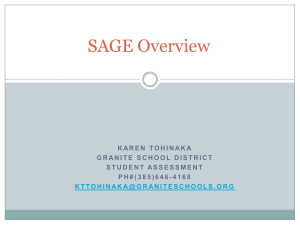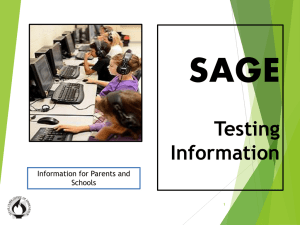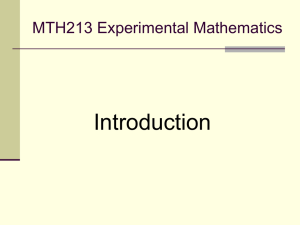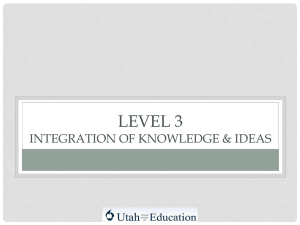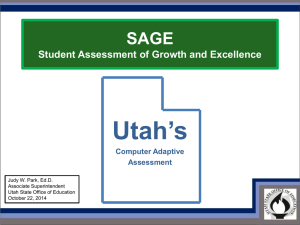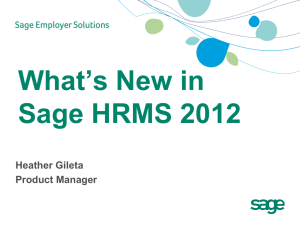Title of Presentation
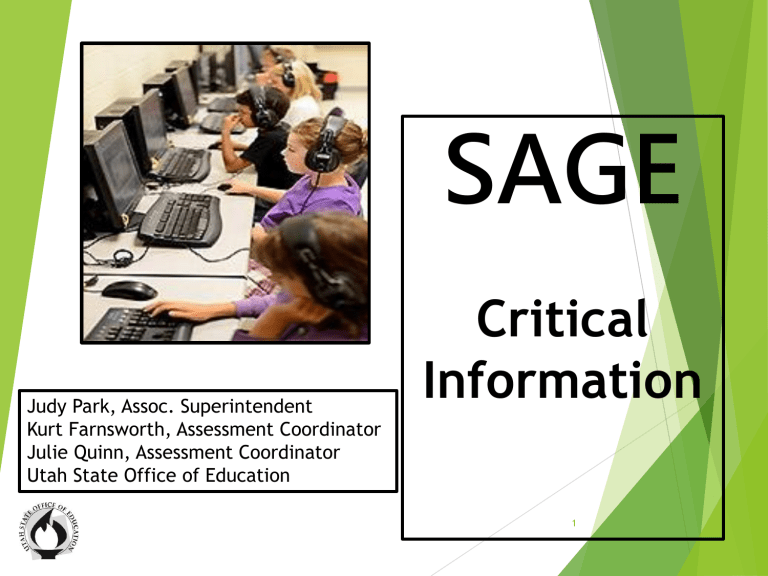
SAGE
Judy Park, Assoc. Superintendent
Kurt Farnsworth, Assessment Coordinator
Julie Quinn, Assessment Coordinator
Utah State Office of Education
Critical
Information
1
Computer
Adaptive
Test
Adaptive 1 st year – 2014
Not fully adaptive due to operational field test
Will need item stats and student scores to be fully adaptive – 2015
Message to the field:
SAGE is an adaptive Test
Students will receive their results (fall)
SAGE results will be used for reporting and accountability
2
Computer
Adaptive
Test
Adaptive Engine – Every student similar experience
Adaptive algorithm used 2014
All assessable standards assessed
Individualized – each student has easy – difficult questions
The first year will provide the data needed to fully adapt to student performance starting with the fall interim in 2014
The same number of questions
All levels of critical thinking
Grade/course level content
Message to the field:
SAGE is an adaptive test
The test will be even more precise after the first year when we have statistics on the questions and baseline data on each student
Every student will be assessed:
on all standards in their grade/course,
all levels of critical thinking
The same number of questions
3
Computer
Adaptive
Test
Adaptive tests measure grade/course content
Scores are not comparable if the content measured is not the same.
If you measure different content for struggling students, teachers will teach different content to those students.
If you measure different content for struggling students, accountability incentives could lock lower performing students into curricula that will not prepare them for college or careers.
Message to the Field
SAGE will assess the abilities of the lowest performing to the highest performing student by providing less difficult to very difficult questions within the grade/course standards in which the student is enrolled.
Participation Policy
Parent Rights
Parents may choose to “Opt out” of testing but send their student to school
Parents may choose to not have their student attend school on testing day
USOE Participation Policy
Policy on Web
http://sageportal.org/wpcontent/uploads/2014/02/Portal_CMS_Tutorial_Resource.pdf
USOE has not created, nor endorsed, nor required a form
All students enrolled in a public school are included in the aggregate data submitted to the federal government, whether they test or not
Absent student = Absent code; no participation, not included in proficiency calculation
Opt out/Refuse to Test = RT code; yes participation, proficiency of 1 (not proficient)
5
Participation Policy
Message to the field:
Parents may choose to not have their students participate in testing
All students enrolled in a public school are included in the aggregate data submitted to the federal government
Students not participating in SAGE, will not receive test results in the fall
Teachers will not receive SAGE results for students not participating in the tests
SAGE results will be used for reporting and accountability
Parents concerned with test questions may:
see the training tests on the public website
http://sageportal.org/training-tests/
Review the comments of the 15 member parent review committee
http://sageportal.org/
6
SAGE Results Reality
Simple Equation
New, more rigorous standards
+
New, more rigorous assessments
=
Reduced % of students proficient
7
SAGE Results Reality
Message to the Field
Reduced proficiency is
A result of more rigorous standards
A result of more rigorous assessments
A result of raising the bar/expectations for all students
Reduced proficiency is not
Decreased student performance
Decreased instructional excellence
Decreased school achievement
Student proficiency will increase as students, parents and teachers work together implementing the standards and assessments
8
SAGE is an assessment
SYSTEM
Formative
Teacher resource
Formative tests & test questions
Instructional resources
Interim
Fall and Midyear adaptive assessments
Similar to summative
Summative
Spring adaptive assessments
Used for state reporting and accountability reports
9
SAGE is an assessment
SYSTEM
Formative
Available November 2013
Version 2 – March 2014
New Features include:
Teacher created items
Enhanced resource bank
Version 3 – May 2014
Status of UTIPS
Old UTIPS ends June 30, 2014
UTIPS Core ends June 30, 2015
10
SAGE is an assessment
SYSTEM
Interim
Available Fall 2014
Fall to Spring growth
Administer only fall or fall and midwinter
Adaptive
Similar to summative test
In the future, may also include smaller test options for specific standards
11
SAGE is an assessment
SYSTEM
Summative
Computer adaptive test
Trimester window begins February 11
Each LEA may only test within a 6 week window
Three week window for early writing only – optional
Results in the fall of 2014
Immediate results beginning in 2015
12
SAGE is an assessment
SYSTEM
Writing
Two prompts
1 st prompt is Opinion/argumentative (longer response)
Students must complete 1 st prompt before they can access the 2 nd prompt
2 nd prompt is informative/explanatory prompt. (shorter response)
Rubrics can be accessed on the SAGE Portal.
http://sageportal.org/resources/?section=5
FAQs
http://sageportal.org/wp-content/uploads/2014/02/Writing-FAQ.pdf
Students can have a blank scratch paper, but needs to be treated as secure material.
Highlighting and an online notepad is also available.
2014 – SAGE writing and DWA
2015 – SAGE writing is the DWA
13
SAGE is an assessment
SYSTEM
Message to the Field
The SAGE assessment system allows formative, interim and summative testing to be aligned components that support each other
Assessment results from all three tests (formative, interim and summative) will be reported on the same reporting system
Formative
Teacher resource
Formative tests & test questions
Instructional resources
Interim
Fall and Midyear adaptive assessments
Fall to spring growth
Similar to summative
Includes two writing prompts
Summative
Spring adaptive assessments
Used for state reporting and accountability reports
2014 fall results; 2015 immediate results
Includes two writing prompts
14
SAGE Training Tests
Purpose
The intention of the Training Test is to teach students how each of the different item types functions.
Audience
Students should experience the Training Test with the support of a teacher so the test’s capabilities (i.e. text-to-speech, annotation, writing, etc.) can be explained. This could be done in a school computer lab, a classroom mobile lab, or on 1-to-1 student computers. Teachers should not simply assign students to take the
Training Test on their own as homework.
Scoring
The Training Test will not score student submissions.
Message to the Field
Teachers and students are encouraged to participate in training tests
Don’t be discouraged
15
Keep in mind, the items are for a grade span that may represent potential difficult items to assess high performing students
SAGE Math Calculator Use
Refer to SAGE TAM & Accommodations Policy
Grades 3 – 4 No calculator
IEPs may appropriately include calculator use for a modified test
Grade 5-7 Two Sections
Calculators used
No calculator allowed
Grade 8 – Math III
Calculators used
Accommodations policy
Use of math tools allowed
One year only adjustments to accommodate field test
5 th grade – short calculator section
7 th grade – short non calculator section
16
SAGE Science Calculator Use
Refer to SAGE TAM & Accommodations Policy
Calculators allowed for all science tests
17
SAGE Student Scores
Standard-setting process:
Broad range of stakeholders (210 participants)
“Ordered Item Booklet”
Impact data, including national and international benchmarks
Resolution process to ensure consistency across grades
State Board of Education approves the process and cut scores.
Cut scores determine what scale score = proficiency
Message to the Field
The process to determine student scores and level of proficiency will use current assessment industry standards. The process and outcome will be reviewed and approved by the Technical Advisory
Committee (assessment expertise in and outside of Utah) and the
State Board of Education
18
SAGE Reporting
Immediate Results
Interim fall 2014
Summative spring 2015
Formative, Interim and Summative results
Interim and Summative results link to formative tools
Student Reports
Classroom Reports
School Reports
SAGE Reporting System will extend current system
Gateway – Public Reporting
Data Display – Password protected data for Educator use
Individual student reports
19
SAGE Reporting
Message to the Field
Immediate Results
Interim fall 2014
Summative spring 2015
Formative, Interim and Summative results
Interim and Summative results link to formative tools
The SAGE reporting system will be an electronic tool that provides data in a variety of ways far beyond what has existed in the past for state testing.
20
SAGE Timeline
April – June Summative Testing
June - August Assessment data analysis and review
August
September
October
Standard Setting
Student results released to LEAs
Accountability reports released to LEAs for 30 day
Nov/Dec review
Accountability reports released to public
Message to the Field
The SAGE timeline is right on schedule
21
Communication Plan
Audience specific brochures
Educators
Legislators
Family
Targeted Outreach meetings
UEA
LEAs
Local Boards
District specialist meetings
District Superintendents
Charter Directors
Business (Prosperity 2020, SL Chamber)
Materials and Templates for LEAs
Develop materials to assist you in your messaging
22
Help?
Help Desk sagehelpdesk@air.org
855-570-7239
Judy Park, Associate Superintendent judy.park@schools.utah.gov
801-376-2326 cell
801-538-7550 office
Kurt Farnsworth, Assessment Coordinator kurt.farnsworth@schools.utah.gov
801-538-7673
Julie Quinn, Assessment Coordinator j ulie.quinn@schools.utah.gov
801-538- 7723
23
Questions?
24
